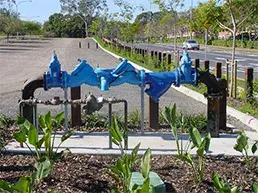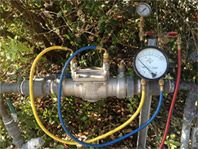What is backflow testing?
Backflow testing ensures the device is working to protect the drinking water in your area. During a backflow test, your plumber will turn off the downstream shut-off valve, wait a few minutes and test the pressure in the system using a special backflow testing kit. The test is carried out to ensure the pressure is as it should be and the device is functioning.
A licenced and accredited backflow prevention plumber is required to test, inspect and commission the backflow devices. Your backflow plumber will submit the completed test report to Sydney Water (or relevant water authority or council) on your behalf.

A backflow device is fitted to the fresh water pipe on your property to stop the flow of water moving back into the mains water system which can occur if there is a difference or drop in water pressure.
Contaminants used in some applications can pose a serious risk to the safety of the fresh water supply in your area. This can potentially allow contaminated water containing such as hazardous chemicals, bacteria and debris to flow back up into the water service.
Backflow prevention devices stop backflow siphonage using either one of these methods:
- a one-way valve
- an air gap
- a break tank
Examples of properties or situations where a backflow prevention device is required include - construction sites, emergency sprinkler or fire service systems, swimming pools, manufacturing facilities, and restaurants with grease traps.
BOOK YOUR ANNUAL BACKFLOW TESTING TODAY
Get professional help, book a great Sydney plumber here
How often does backflow testing need to be done?
Properties with a high or medium hazard rating must have a backflow device test carried out after the device installation and then once a year after that.
Low hazard properties are usually fitted with a non-testable backflow device. Many smaller Sydney Water meters (20 or 25 mm) are fitted with a backflow prevention device which is suitable for low-risk use.

Your installation plumber will carry out a hazard assessment to establish the risk level of your property.
Cross-connections are rated using three degrees of hazard:
High Hazard: Any condition, device or practice that, in connection with the water supply system, has the potential to cause death.
Medium Hazard: Any condition, device or practice that, in connection with the water supply system, has the potential to endanger health.
Low Hazard: Any condition, device or practice that, in connection with the water supply systems, constitutes a nuisance but does not endanger health or cause injury.
Need a backflow test carried out at your Sydney property? Book our experienced plumbing team today.
More information on Backflow Prevention Testing.
